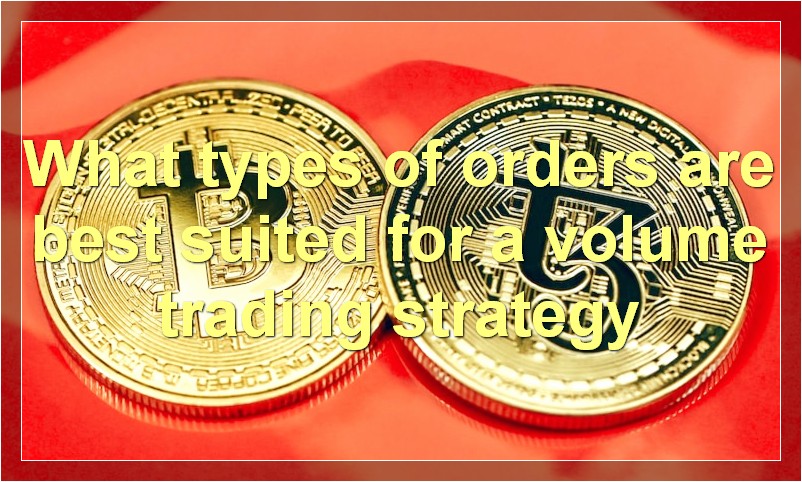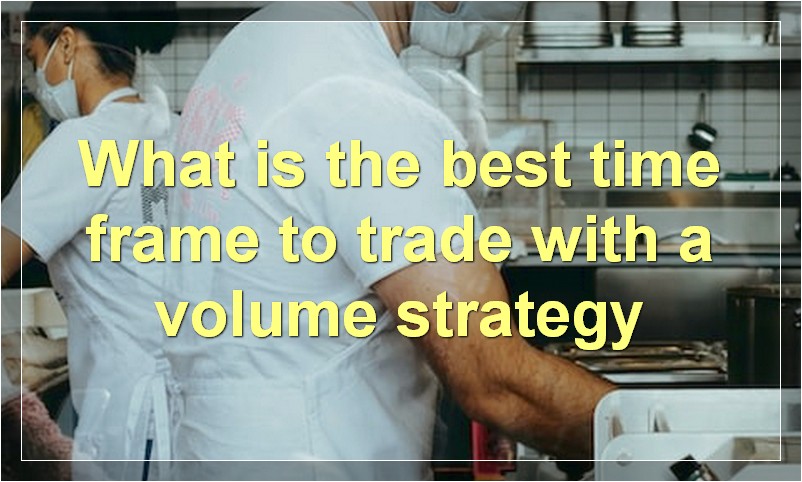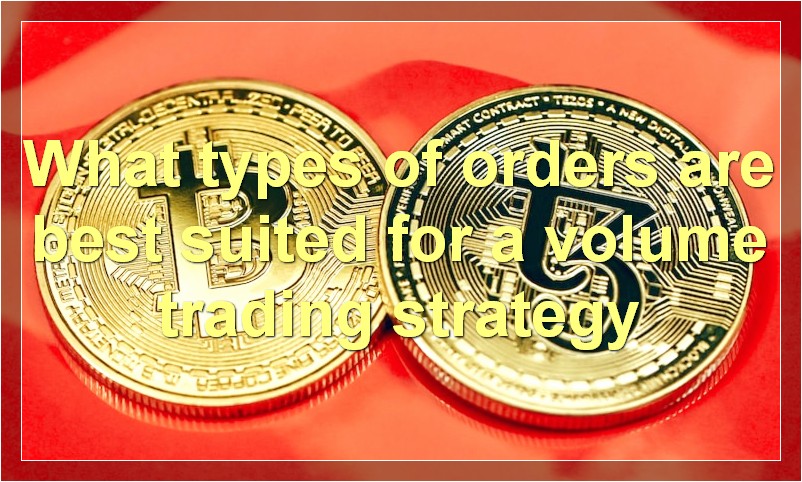In order to trade successfully, you need to have a clear understanding of volume. This guide will teach you everything you need to know about volume trading strategies.
What is the most important factor to consider when implementing a volume trading strategy
The most important factor to consider when implementing a volume trading strategy is the risk management.
It is essential to have a clear understanding of the risks involved in volume trading before implementing such a strategy. The potential rewards of successful volume trading are high, but so are the risks.
There are a number of different risks associated with volume trading, including:
Market risk: This is the risk that the markets will move against your position.
counterparty risk: This is the risk that your counterparty will not honor their obligations under the contract.
liquidity risk: This is the risk that you will not be able to exit your position at your desired price.
To minimise these risks, it is essential to have a sound risk management strategy in place before embarking on volume trading. This should include elements such as stop-losses and position sizing.
By carefully managing the risks involved in volume trading, you can maximise your chances of success and reap the rewards of this lucrative trading strategy.
What types of orders are best suited for a volume trading strategy

There are a few different types of orders that are best suited for volume trading strategies. The first type of order is a limit order. This type of order allows you to set the maximum price you are willing to pay for a security, or the minimum price you are willing to sell it for. The second type of order is a market order. A market order is an order to buy or sell a security at the current market price. The third type of order is a stop-loss order. This type of order is used to limit your losses in a security by selling it automatically if it reaches a certain price.
How do you determine the appropriate level of risk for a volume trading strategy
There is no single answer to this question as it will depend on a number of factors, including the trader’s own risk tolerance and the potential rewards of the strategy. A good starting point is to consider the worst-case scenario of the strategy and whether the trader is comfortable with that level of risk. Other factors to consider include the win-rate of the strategy and the average size of the losses.
What are some common pitfalls associated with volume trading strategies
When it comes to volume trading strategies, there are a few common pitfalls that traders should be aware of. One of the biggest dangers of trading with high volume is that it can lead to overtrading. This means that traders may take too many trades, or hold on to positions for too long, leading to losses.
Another common mistake is not managing risk properly. With high volume trading comes the potential for higher profits, but also higher losses. This is why it is so important to set stop-losses and take-profits, as well as using proper position sizing.
Finally, another danger of volume trading is getting caught up in the excitement and forgetting to stick to your plan. When prices are moving fast, it can be easy to get caught up in the moment and make impulsive decisions. This is why it is so important to have a well-defined strategy before you start trading, and to stick to it no matter what.
How can you effectively manage your emotions when trading with a volume strategy
When trading with a volume strategy, there are a few things you can do to effectively manage your emotions. First, it is important to have a clear understanding of what your goals are and what you are trying to achieve with your trading. This will help you maintain focus and not let your emotions get the best of you. Second, you need to develop a trading plan that includes risk management. This will help you limit your losses and keep your emotions in check. Finally, it is important to stay disciplined with your trading. This means following your plan and not letting your emotions influence your decisions.
What is the best time frame to trade with a volume strategy

The answer to this question depends on the trader and their individual trading strategy. Some volume traders may find that intraday trading works best for them, while others may prefer to trade over a longer period of time. There is no one-size-fits-all answer to this question.
That said, there are a few things that all volume traders should keep in mind when choosing a time frame for their trading. First, volume tends to be highest during market hours. This means that there will be more opportunities for trades during this time. Second, volume traders should make sure to pay attention to the release of economic data. This data can have a big impact on markets and can cause volatility. Finally, it’s important to remember that the volume strategy is just one tool in a trader’s toolbox. Traders should also consider other factors, such as price action and technical analysis, when making trading decisions.
What are some common indicators used in conjunction with a volume trading strategy
When it comes to volume trading, there are a few indicators that are commonly used in conjunction with this strategy. Some of these indicators include the following:
1) The amount of volume traded on a given day. This is often considered to be one of the most important indicators when it comes to volume trading, as it can give you an idea of how much interest there is in a particular stock or security.
2) The average volume traded over a period of time. This can be helpful in spotting trends in volume trading, as well as identifying potential opportunities.
3) The ratio of buy orders to sell orders. This is another important indicator, as it can help you gauge the mood of the market and whether there is more buying or selling pressure present.
4) The price action in relation to the volume traded. This is yet another important indicator, as it can help you confirm trends or reversals.
5) Other technical indicators. There are a number of other technical indicators that can be used in conjunction with volume trading, such as moving averages, support and resistance levels, etc.
By keeping an eye on all of these indicators, you will be able to get a better picture of the overall market sentiment and identify potential opportunities for making profits through volume trading.
How can you adapt a volume trading strategy to changing market conditions
As a volume trader, you are always looking for ways to increase your profits while reducing your risk. One way to do this is to adapt your volume trading strategy to changing market conditions.
There are a number of ways you can do this. First, you can adjust the number of shares you trade based on the overall volume in the market. If the market is extremely volatile, you may want to trade fewer shares so that you don’t get caught up in the volatility.
Second, you can adjust your stop losses and profit targets based on the current market conditions. If the market is trending higher, you may want to adjust your profit target accordingly. Conversely, if the market is trending lower, you may want to adjust your stop loss accordingly.
Finally, you can also tweak your entry and exit strategies based on the current market conditions. For example, if the market is very overbought, you may want to wait for a pullback before entering a trade. Conversely, if the market is very oversold, you may want to enter a trade immediately.
By adapti
What are some methods for scaling into and out of positions when using a volume trading strategy
One common method for scaling into and out of positions when using a volume trading strategy is to use what’s called a “pyramid” approach. This involves adding to your position as the market moves in your favor, and then selling off part of your position as the market starts to turn against you. This allows you to take profits while still maintaining a core position in the market.
Another common method is to simply scale into and out of your positions based on set levels that you determine in advance. For example, you might buy 1/3 of your position when the market first breaks above a key resistance level, then add another 1/3 of your position once it reaches a certain profit target. Finally, you would sell off the final 1/3 of your position once it hits your stop-loss level.
There are a number of different ways that traders can scale into and out of positions, and there is no one “right” way to do it. The important thing is to have a plan in place before you enter any trade, so that you know exactly how you will exit the trade if things go against you.
Are there any special considerations that need to be made when using stop-losses with a volume trading strategy
When using stop-losses with a volume trading strategy, there are a few special considerations that need to be made. First, it is important to make sure that the stop-loss is placed at a level that will allow the trade to still be profitable even if it is stopped out. Second, it is important to make sure that the stop-loss is not too close to the current price, as this could result in the trade being stopped out prematurely. Finally, it is important to make sure that the stop-loss is not too far from the current price, as this could result in the trade missing out on potential profits.

